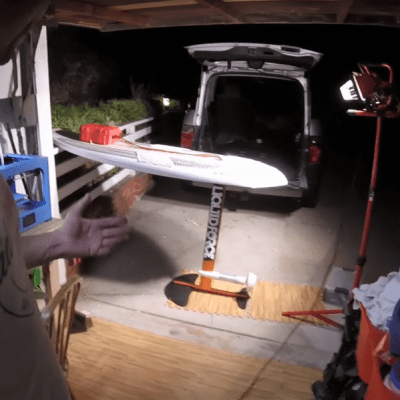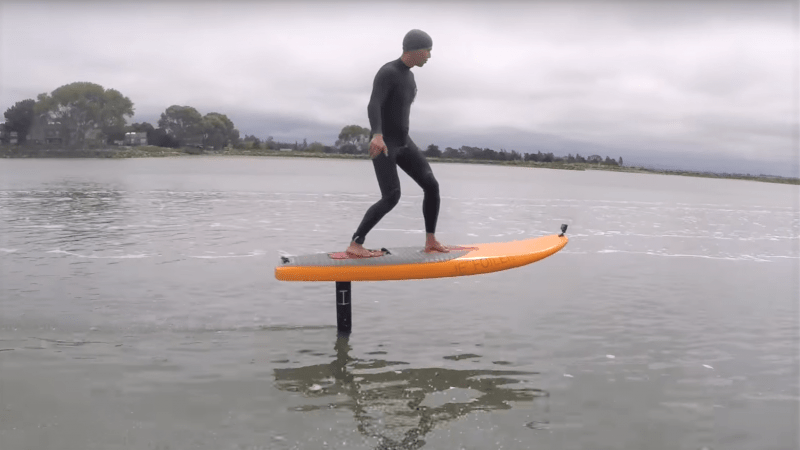Paddleboards, which are surfboard-like watercraft designed to by stood upon and paddled around calm waters, are a common sight these days. So imagine the surprise on the faces of beachgoers when what looks like a paddleboard suddenly but silently lurches forward and rises up off the surface, lifting the rider on a flight over the water.
 That may or may not be [pacificmeister]’s goal with his DIY 3D-printed electric hydrofoil, but it’s likely the result. Currently at part 12 of his YouTube playlist in which he completes the first successful lift-off, [pacificmeister] has been on this project for quite a while and has a lot of design iterations that are pretty instructive — we especially liked the virtual reality walkthrough of his CAD design and the ability to take sections and manipulate them. All the bits of the propulsion pod are 3D-printed, which came in handy when the first test failed to achieve liftoff. A quick redesign of the prop and duct gave him enough thrust to finally fly.
That may or may not be [pacificmeister]’s goal with his DIY 3D-printed electric hydrofoil, but it’s likely the result. Currently at part 12 of his YouTube playlist in which he completes the first successful lift-off, [pacificmeister] has been on this project for quite a while and has a lot of design iterations that are pretty instructive — we especially liked the virtual reality walkthrough of his CAD design and the ability to take sections and manipulate them. All the bits of the propulsion pod are 3D-printed, which came in handy when the first test failed to achieve liftoff. A quick redesign of the prop and duct gave him enough thrust to finally fly.
There are commercially available e-foils with a hefty price tag, of course; the header image shows [pacificmeister] testing one, in fact. But why buy it when you can build it? We’ve seen a few hydrofoil builds before, from electric-powered scale models to bicycle powered full-size craft. [pacificmeister]’s build really rises above, though.
[pacificmeister], if you’re out there, this might be a good entry in the Hackaday Prize Wheels, Wings, and Walkers round. Just sayin’.
Thanks to [Reuben] for the tip on this one.
















Sweet!
Just a couple more things are needed:
This is for your board: https://goo.gl/RjP5mo
This is for your board: https://goo.gl/vUWKYv
You know where I am going with this! https://goo.gl/eLs1az
First “for your board” was meant to say “for you”
Silver surfer (saved you some clicks)
Booooo
Trolling motor tech is fantastic and cheap these days. As Dan mentioned, so are paddleboards. I love it that readily available CAD and 3D printing make a project like these (iterative prototyping) possible for your common hacker. This ability to take multiple well-engineered consumer goods and combine theme into something custom and excellent is so satisfying.
The foil is crazy expensive for what amounts to a piece of aluminum extrusion and something you can easily print on the 3D printer. That’s what really begs for being made here; the rest of the project was doing not much more than putting stuff together.
Well, one could 3D print a negative mold with very minimal infill, fill the voids with something like plaster and then you have a usable mold for DIY carbon fiber composite parts…
It’s surprisingly easy to work with, not even all that expensive (especially if the comercial hydrofoil and mast is $600, that should be very easy to beat) and if you don’t mind too much that you will reach maybe say, 60-80% weight/strength ratio to an autoclaved part, you don’t need an autoclave.
why aluminum? all you need is marine plywood, epoxy, angle grinder and free weekend
https://www.seabreeze.com.au/News/Kitesurfing/How-to-make-your-own-Hydrofoil_8649403.aspx
and video tutorial for a $100 wooden kit:
https://www.youtube.com/watch?v=qVcNdiaX0GE
looks like something johnny quest would’ve had
The prop is printed as well!? Nice!
Really sweet.
I like that kind of speed from just electric.
This is a cool build. Good job!
Needs to embed the batteries in the board. Maybe integrate some 6 axis sensors in there and possibly add thrust vectorization? I have seen quite a few companies with commercially available products out there recently. Always neat to see it as a DIY project.
https://www.youtube.com/watch?v=aIxgIVFKuAQ&t=6s
He should replace the riser with a clear acrylic or poly-carbonate.
It’d look cool but be far too heavy at the size needed to support the board and not break from torque.
@pacificmeister if you’re reading this: The efficiency of an airfoil (or hydrofoil in this case) depends on its aspect ratio. That would be the width of the wing divided by the chord. With wings not being rectangular that’s a difficult thing to determine exactly, so the current definition does something with the area and the span. It’s the same for a rectangle, but comes out nicely for everything else.
Your wing is quite stubby, low aspect ratio. Two at the most. If you manage to increase that to say 5 or 8, then you’ll see an improved riding time for your batteries. I’m guessing up to a factor of two!
He’s using a $600 commercial foil and mast. That’s what is most disappointing about the project for me – he’s assembling commercial components.
Small steps. At some point those might be self-built as well.
Great Idea make it a commercial product and you would have a success.
Should have looked at the video above, already a commercial product!
Even the dog was impressed. Very nice DIY work.
Dogs are easy to impress. Now if it was a Cat ….
https://www.youtube.com/watch?v=SxwGzpd1PQk
it looks great, but the sound of the engine is extremely annoying. I don’t understand why the engine has to play this annoying music.
What is Pacific Meistersinger contact info ?
He is breaking the speed limit for that area. [Looks like MDR]
Wow, by sheer coincidence,, I was looking at some of his earlier videos just a few days ago.
Very cool
@pacificmeister Awesome work man! Absolutely love this project in the process of making an electric kayak and I found your project!
What PacificMeister has shown is possible has really opened the doors and I’m building my own, similar to his at first glance but have some really exciting design changes in the works. You can follow my build at http://www.DIY-Electric-Hydrofoil.com if anyone is interested.
There is new electric hydrofoil being developed on Kickstarter that will bolt onto almost any hydrofoil using different mount types and the project ends in 24 hours.
https://www.kickstarter.com/projects/834430643/diy-electric-hydrofoil-and-surfboard-remote-propul